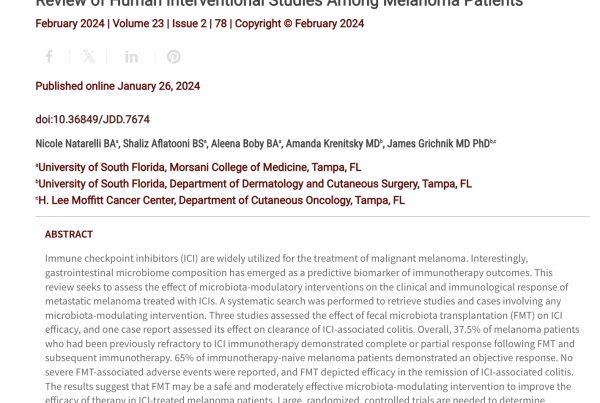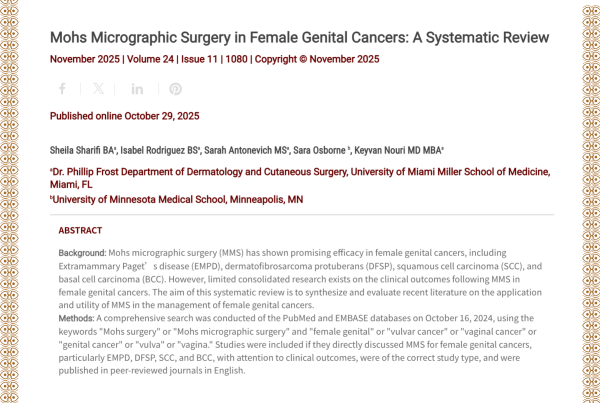Skin Cancer Articles
Basal Cell Carcinoma Gene Mutations Differ Between Asian, Hispanic, and Caucasian Patients: A Pilot Study
Marissa Lobl BS, Blake Hass BS, Dillon Clarey MD, Shauna Higgins MD, Adam Sutton MD MBA, Ashley Wysong MD MS
To our knowledge, no published studies have evaluated differences in specific somatic gene mutations in basal cell carcinoma for patients of different races, ethnicities and/or skin of color. This pilot study aims to analyze the somatic gene mutations and how they might differ between Caucasian, Asian, and Hispanic patients. J Drugs Dermatol. 20(5):504-510. doi:10.36849/JDD.5884
The Potential Efficacy of β-Blockers on Melanoma Survival: A Narrative Review
Mohamad Goldust MD, Zoe Apalla MD, Jacek C. Szepietowski MD, Mrinal Gupta MD, Torello Lotti MD
β-blockers have recently demonstrated in preclinical and clinical studies to reduce recurrence and to correlate with better overall survival in meta-static melanoma as an additional supportive treatment option. Our aim is to evaluate the role and current status of β-blockers in melanoma management. J Drugs Dermatol. 20(4):380-383. doi:10.36849/JDD.5673
A Review of Hedgehog Inhibitors for Treatment of Advanced Basal Cell Carcinoma
Michael Migden MD, Aaron S Farberg MD, Reinhard Dummer MD, Nicholas Squittieri MD, C. William Hanke MD
The systemic Hedgehog inhibitors (HHIs) are the only approved pharmacologic treatment option for advanced basal carcinoma. This review compares efficacy, safety, and pharmacokinetics based on published literature to date. J Drugs Dermatol. 20(2):156-165. doi:10.36849/JDD.2021.5657 [FREE]
A Non-Surgical and Cost-Effective Treatment Approach Employing A Unique Topical Combination for Primary Non-Melanoma Skin Cancers
William J. Nahm BA, John Shen MD, Patrick M. Zito DO PharmD, Adrianna M. Gonzalez MD, Nicole Nagrani MD, Kevin Moore MD MPH, Evangelos V. Badiavas MD PhD, Robert S. Kirsner MD PhD, Anna J. Nichols MD PhD
Alternative approaches to treating non-melanoma skin cancers remain limited and unproven. We assess the efficacy of varying combinations of anti-tumor topical agents—5% cream, 2% solution, and 0.1% cream—with brief cryotherapy in treating non-melanoma skin cancers.
Impact of a 31-gene Expression Profiling Test for Cutaneous Melanoma on Dermatologists’ Clinical Management Decision
Following a diagnosis of cutaneous malignant melanoma (CMM), patients are often guided for subsequent management by their dermatologist and national guideline recommendations. Guidelines recommend diagnostic tests and additional evaluation which may provide defined treatment protocols, surveillance, and follow-up. Unfortunately, these recommendations fall short. [FREE]
The Influence of Supportive Oncodermatology Interventions on Patient Quality of Life: A Cross-Sectional Survey
Supportive oncodermatology is a growing field that provides treatment and preventive care to oncology patients who experience dermatologic adverse events (dAEs) secondary to cytotoxic and targeted cancer treatments. Novel cancer therapies that impede the proliferation of cancer cells often target other rapidly proliferating organ systems and can lead to unfavorable skin, hair, and nail alterations. The most commonly documented dAEs include papulopustular rash, xerosis, pruritus, nail changes, chemotherapy-induced alopecia, and hand-foot skin reaction. Over 50% of cancer patients experience an interruption in therapy secondary to dAEs. All patients receiving anticancer therapy may be vulnerable to dAEs and the consequent impacts on wellness and treatment adherence.
Real-World Utility of a Non-Invasive Gene Expression Test to Rule Out Primary Cutaneous Melanoma: A Large US Registry Study
Histologic criteria to distinguish between benign and malignant are overlapping and are in nature subjective, affecting the performance of our existing mainstay of establishing diagnoses in pigmented lesion management. Dermoscopy, confocal microscopy, or computer-aided image analysis generally do not overcome issues and challenges after biopsy decisions have been made.
Long-Term Benefits of Daily Photo-Protection With a Broad-Spectrum Sunscreen in United States Hispanic Female Population
This study is to our knowledge the first one to demonstrate the benefits of long-term daily use of sunscreen on signs of aging and pigmentary concerns in patients with higher phototypes. There is in general a lack of knowledge on the long-term impact of daily photoprotection on skin of color. We investigated SPF 30/PPD 20 (Persistent Pigmentation Darkening rating = UVA protection) use in phototype IV and V Hispanic females versus a real life population without use. J Drugs Dermatol. 2020;19(3): doi:10.36849/JDD.2020.4836 [FREE]
Long-Term Efficacy and Safety of Superficial Radiation Therapy in Subjects With Nonmelanoma Skin Cancer: A Retrospective Registry Study
Nonmelanoma skin cancer (NMSC) comprises basal cell carcinoma (BCC), squamous cell carcinoma (SCC), and numerous less common skin tumors. NMSCs are the commonest form of malignancy among Caucasians and its incidence continues to rise worldwide. Although Mohs surgery has traditionally been regarded as the gold-standard for treating NMSC, it may not be suitable for the elderly due to frailty, limited life-expectancy, and comorbidities.
Non-Invasive Buccal Swab Gene Testing for Skin Cancer Risk
Major DNA repair defects can give rise to cancer-prone phenotypes. This phenomenon is illustrated in xeroderma pigmentosum, a disease with mutated repair genes that predispose patients to extreme UV sensitivity and 2,000-fold risk of non-melanoma skin cancers and other malignancies. The variants in DNA repair genes for the general population and the association with cancer risk is not yet well understood.
Skin Cancer Epidemiology and Sun Protection Behaviors Among Native Americans
Is It Time to Rethink What Thickness Really Means as a Prognostic Indicator in Melanoma? Ten Questions We Should Be Asking Ourselves
With the advent of gene expression profile (GEP) assays for melanoma and the discovery of multiple melanoma subtypes. We present ten questions for consideration by the shrewd practitioner when considering prognostic factors of melanoma.
Sponsored
Podcast Episodes
Support the (On)cause: A Practical Review of Supportive Oncodermatology
Dr. Mario Lacatoure joins podcast host Dr. Adam Friedman to discuss the array of cutaneous clusters that not only can, but are almost expected to occur during cancer therapy. Learn how even simple OTC products can contribute to both ameliorating and even preventing some of these sequelae.
Variations in Skin Cancer Screening Practices Among Dermatologist
Dr. Adam Friedman and Dr. Evan Rieder (double board-certified in dermatology and psychiatry) in the U.S., discuss “Dermatologist Practices During Total Body Skin Examinations: A Survey Study.” Do we all do it the same? Are we all checking every nook and cranny? Do we need better standardization for our greatest weapon to enable early and life saving skin cancer detection?
Case Reports
Basal Cell Carcinoma in the Nasal Vestibule
We report the first case of BCC in the nasal vestibule. Read how the lesion was treated.
Combination Topical Chemotherapy for the Treatment of an Invasive Cutaneous Squamous Cell Carcinoma
Surgery may not be ideal for elderly patients with numerous lesions, who are poor surgical candidates or who refuse surgery. Topical 5-FU and immune response inhibitor cream have been studied off-label as monotherapies in the treatment of SCC in situ with promising results.
.
Recurrent Squamous Cell Carcinoma Arising Within a Linear Porokeratosis
A case of linear porokeratosis with recurrent malignant degeneration to squamous cell carcinoma (SCC) recurring six years after excision of initial SCC. Physical examination revealed a 3.5 x 2.7 cm friable tumor on the left proximal posterior thigh.
Sponsored
JDD Blog










